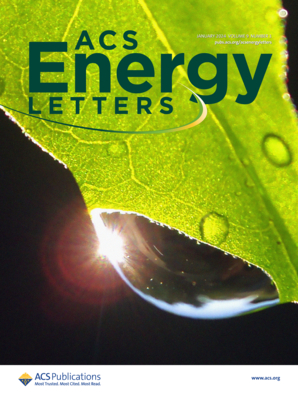Multicomponent Solvent Engineered Spatially Uniform 2D/3D Perovskite Heterojunction for Solar Cells
IF 19.3
1区 材料科学
Q1 CHEMISTRY, PHYSICAL
引用次数: 0
Abstract
This study introduces a multicomponent solvent engineering approach for constructing high-quality 2D/3D metal halide perovskite (MHP) heterostructures, addressing vertical inhomogeneity in ultrathin 2D capping layers for perovskite solar cells (PSCs). Through synergistic solvent coordination, isopropyl alcohol spatially confines 2D layer formation at the 3D perovskite surface, while dimethyl sulfoxide induces controlled 3D matrix dissolution to enable vertical phase propagation. Acetonitrile optimizes solvent penetration dynamics, achieving 2D layers with exceptional spatial homogeneity across multiple cation systems. The optimized PDAI2-derived 2D/3D architecture demonstrates a certified power conversion efficiency (PCE) of 25.57% (champion 26.14%) with an 85.62% fill factor, attributed to enhanced interfacial charge transport at the C60/perovskite junction through reduced nonradiative recombination. The spatially uniform 2D capping layer confers remarkable operational stability, retaining 92% initial PCE after 5,000 h dark aging and 90% efficiency following 1,700 h maximum power point tracking under continuous 1-sun illumination.

求助全文
约1分钟内获得全文
求助全文
来源期刊

ACS Energy Letters
Energy-Renewable Energy, Sustainability and the Environment
CiteScore
31.20
自引率
5.00%
发文量
469
审稿时长
1 months
期刊介绍:
ACS Energy Letters is a monthly journal that publishes papers reporting new scientific advances in energy research. The journal focuses on topics that are of interest to scientists working in the fundamental and applied sciences. Rapid publication is a central criterion for acceptance, and the journal is known for its quick publication times, with an average of 4-6 weeks from submission to web publication in As Soon As Publishable format.
ACS Energy Letters is ranked as the number one journal in the Web of Science Electrochemistry category. It also ranks within the top 10 journals for Physical Chemistry, Energy & Fuels, and Nanoscience & Nanotechnology.
The journal offers several types of articles, including Letters, Energy Express, Perspectives, Reviews, Editorials, Viewpoints and Energy Focus. Additionally, authors have the option to submit videos that summarize or support the information presented in a Perspective or Review article, which can be highlighted on the journal's website. ACS Energy Letters is abstracted and indexed in Chemical Abstracts Service/SciFinder, EBSCO-summon, PubMed, Web of Science, Scopus and Portico.
 求助内容:
求助内容: 应助结果提醒方式:
应助结果提醒方式:


